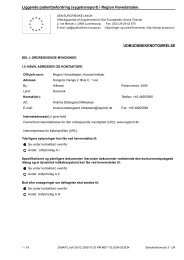Territorial Review Copenhagen - Region Hovedstaden
Territorial Review Copenhagen - Region Hovedstaden
Territorial Review Copenhagen - Region Hovedstaden
You also want an ePaper? Increase the reach of your titles
YUMPU automatically turns print PDFs into web optimized ePapers that Google loves.
155<br />
might be regarded as an emerging sixth finger. It is estimated that the<br />
population of the Øresund <strong>Region</strong> will grow by approximately 200 000 in 20<br />
years. Accompanying the population increase and possible economic<br />
integration, it is also estimated that car traffic across the bridge will increase<br />
from an average of 18 500 vehicles per day in 2007 to 49 000 vehicles per<br />
day in 2025 and that the number of daily commuters across Øresund will<br />
increase from 17 600 individuals per day in 2007 to approximately 56 000 in<br />
2025. 12 Commuting will, according to these expectations, account for half of<br />
all passenger car traffic on the bridge in 2015. The current situation, with<br />
higher wages in <strong>Copenhagen</strong> and lower housing/living costs in Skåne, will<br />
lead to the emergence of one functional area sooner or later. Rush-hour<br />
traffic will be the most urgent challenge. The bridge itself is likely to<br />
support the increase of passengers for the coming decade, while the roads<br />
and rail in <strong>Copenhagen</strong> might run into difficulties dealing with the<br />
additional traffic, for example in the connection with the city centre and<br />
with the airport, as the arrangement of the Øresund Link required each<br />
country to take independent responsibility for domestic access to the link.<br />
The central and local government could profit from taking some measures to<br />
counter the bottleneck.<br />
To face the challenges, the Capital <strong>Region</strong>‘s Development Plan, in<br />
accordance with the Finger Plan, promotes expansion of public transport in<br />
densely populated areas and on the large approach roads. This is a step in<br />
the right direction, but a solution from supply side, through increase of<br />
transportation capacity, should be linked with the demand side, through land<br />
use planning that influences transportation needs. Transportation planning<br />
should be clearly co-ordinated with land use plans such as the Finger Plan.<br />
Since transportation infrastructure planning falls under the jurisdiction of<br />
Ministry of Transport, while spatial planning is under the Ministry of<br />
Environment, both ministries will need to co-ordinate to achieve effective<br />
and efficient regional structures.<br />
…requires more integrated transport planning<br />
At the national level, it is not clear how to prioritise infrastructure<br />
development among many transportation mode and regions. National<br />
Transport Agreements intend to prioritise investments in road and rail<br />
infrastructure. Agreements in 2003 and 2005 focused on congestion relief<br />
and international links. The 2006 agreement focused on restoration of the<br />
rail network and new road construction. For the coming government<br />
investment plans, the national government established the Infrastructure<br />
Commission, whose task is to assess key challenges and potentials towards<br />
2030, present strategic options and priorities, give advice on public-private<br />
partnerships (PPPs), environmentally friendly transportation and evaluate<br />
organisation for physical planning. The Commission issued a report in 2008,

















